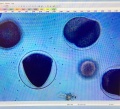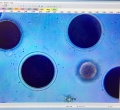Difference between revisions of "Ovoperoxidase from Sea Urchins"
| Line 2: | Line 2: | ||
The main goal of this project is to isolate the sea urchin ovoperoxidase enzyme and collect data about it's activity and reactions with hydrogen peroxide. Former student Laura Sanchez was isolating the protein, but upon graduation her work was passed down to Emily Rein who will continue to work on isolating the enzyme for our use. | The main goal of this project is to isolate the sea urchin ovoperoxidase enzyme and collect data about it's activity and reactions with hydrogen peroxide. Former student Laura Sanchez was isolating the protein, but upon graduation her work was passed down to Emily Rein who will continue to work on isolating the enzyme for our use. | ||
| + | |||
| + | The following video portrays the actual fertilization process for sea urchins: | ||
[https://www.youtube.com/watch?v=fO4UWj01Gx8 Fertilization Video] | [https://www.youtube.com/watch?v=fO4UWj01Gx8 Fertilization Video] | ||
| + | |||
| + | The following link shows the anatomy of a sea urchin: | ||
[https://en.wikipedia.org/wiki/Sea_urchin#/media/File:Urchin9b.jpg Sea Urchin Anatomy] | [https://en.wikipedia.org/wiki/Sea_urchin#/media/File:Urchin9b.jpg Sea Urchin Anatomy] | ||
Revision as of 19:15, 17 June 2019
Project Overview
The main goal of this project is to isolate the sea urchin ovoperoxidase enzyme and collect data about it's activity and reactions with hydrogen peroxide. Former student Laura Sanchez was isolating the protein, but upon graduation her work was passed down to Emily Rein who will continue to work on isolating the enzyme for our use.
The following video portrays the actual fertilization process for sea urchins:
The following link shows the anatomy of a sea urchin:
The Sea Urchins
Gulf Specimen Marine Laboratories is the vendor through which we purchased the sea urchins for research. We purchased around 12 fertilized sea urchins, and were able to collect eggs from one sea urchin out of the first batch.
Below is a link to the website from which we ordered the sea urchins:
Gulf Specimen Marine Laboratories
The following images are of the sea urchin eggs we abstracted.
Egg Extraction
0.5 mL of 0.55 M KCl was injected into the sea urchins to cause them to release their eggs/sperm. 0.25 mL was injected into either side of the mouth. After the KCl was injected, the urchins were overturned on a beaker to release the eggs/sperm.
The first round of sea urchins had only 4 females.
The following video was used as references to guide our lab experience.
Our Lab Experience
Instrumentation
The UV-Vis is the main instrument we use to analyze the peroxidase.
The following link explains the procedure used with the UV-Vis.
References
Sea Urchin Fertilization Lab - Brad's Page
Scots J-Term Andros Island
January 4th through January 12th of 2019 my research advisor, Brad Sturgeon, along with 7 other students and myself, visited Forfar Field Station on Andros Island in the Bahamas. There I was able to learn about the natural environment of sea urchins We also gained field experience by studying them through snorkeling. The interns at Forfar were very knowledgeable about the area and the creatures inhabiting the ocean around the island.
Below is a link to an article written about the trip as a whole:










